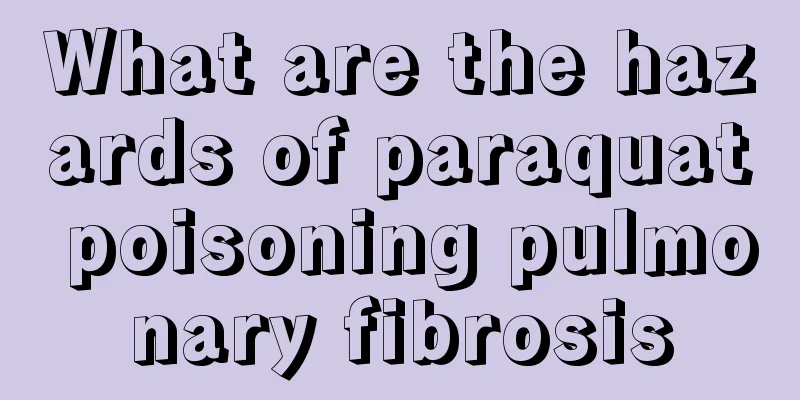What are the hazards of paraquat poisoning pulmonary fibrosis

|
Paraquat is a pesticide widely used in rural areas. Due to its strong toxicity, the damage it causes to the human body is often fatal. In many rural areas, paraquat poisoning due to accidental ingestion or poisoning often directly causes respiratory and lung problems, among which lung tissue damage is the most serious. Pulmonary fibrosis caused by paraquat poisoning is also a common sequelae of poisoning. Pulmonary fibrosis is the most serious disease in paraquat poisoning The chemical name of paraquat is 1-1-dimethyl-4-4-bipyridinium chloride, also known as paraquat, chloranil, and paraquat. Accidental oral ingestion of more than 30 ml of 20% aqueous solution can cause death. Paraquat can be absorbed through the skin, respiratory tract and digestive tract, but the absorption is not complete. After absorption, it is distributed to various tissues and organs throughout the body with the blood, but the content in the lung tissue is the highest. Paraquat is rarely degraded in the body and is often excreted in its original form in feces and urine. A small amount can be excreted through breast milk. 1. Causes damage to multiple systems Paraquat poisoning can cause damage to multiple systems, especially pulmonary fibrosis, which is the most serious. It can cause congestion, hemorrhage, edema, hyaline membrane formation, degeneration, hyperplasia, fibrosis and other changes in lung tissue. Large-dose poisoning often causes death due to respiratory failure and multiple organ failure such as heart, liver, and kidney caused by acute lung injury; smaller-dose poisoning often causes later lung tissue fibrosis, with a relatively long course of disease. Progressive, diffuse, and irreversible pulmonary fibrosis is the main cause of death in patients who survive the acute phase of poisoning. 2. Induce acute inflammatory response in lung tissue, causing acute lung damage and leading to alveolitis The main target organ of paraquat poisoning is the lung tissue. It can be actively transported and taken up into the lung type I and II cells, making the concentration of paraquat in the lung tissue 6-10 times higher than the plasma concentration. It can also cause redox reactions in the cells. The oxygen free radicals converted in cells are the basis of paraquat's toxic effects. The large amount of superoxide anion free radicals (O=) and hydrogen peroxide (H2O2) formed can induce acute inflammatory response in lung tissue, causing acute lung damage and leading to alveolitis. Pathological changes in lung tissue after paraquat poisoning 1. After paraquat poisoning, it induces inflammatory cell aggregation and cytokine activation, generating a large amount of fibrinous inflammatory exudate, filling the small bronchi and alveoli of the lungs with protein inflammatory exudate, inflammatory cells and degenerated bronchial epithelial cells caused by poisoning, causing the degeneration of type II alveolar epithelial cells and the formation of hyaline membranes, affecting the secretion of surfactant by alveolar epithelial cells. 2. Reduced secretion or impaired secretion of pulmonary surfactant causes the alveolar wall to collapse. The collapsed alveolar cavity and the exposed alveolar wall adhere to each other through protein substances such as cellulose, resulting in occlusion and disappearance of the alveolar cavity. 3. Inflammatory cells and cytokines stimulate and activate the originally dormant fibroblasts, transforming them into myofibroblasts. On the one hand, it proliferates in the pulmonary interstitium and secretes a large amount of matrix proteins, causing pulmonary interstitial fibrosis. On the other hand, it is induced by the chemotaxis produced by inflammatory factors and cytokines in the alveoli, enters the alveolar cavity through the damaged alveolar epithelium and basement membrane and proliferates, secreting a large amount of matrix proteins. The blocked alveolar cavity is eventually filled and replaced by matrix proteins, resulting in irreversible alveolar fibrosis. This causes fibrosis of the entire lung tissue, leading to respiratory failure and death. Irreversible fibrosis of lung tissue caused by paraquat poisoning is the main cause of death from paraquat poisoning. It is hoped that clinicians can be inspired and learn from this to intervene artificially and prevent the occurrence of irreversible fibrosis of lung tissue. Strive to cure more patients suffering from paraquat poisoning. |
<<: What medicine is good for arteriosclerosis?
>>: What are the causes of atherosclerosis
Recommend
Can a bitten tongue heal itself?
Generally speaking, if the tongue is bitten, as l...
What are the benefits of washing your face with milk
Since ancient times, milk has been a pure natural...
Reference table for weight gain during pregnancy
It is well known that women's weight will inc...
Chlamydia trachomatis nucleic acid detection accuracy
Chlamydia trachomatis can cause a variety of dise...
How to plug a red wine bottle
Sometimes it is impossible to finish drinking red...
What are the hazards of grilled sausages
In our daily life, we are always attracted by var...
What should I do if I have finger muscle pain?
Hands are a part of our body that we move on a da...
What is the immune status of bladder cancer
In recent years, bladder cancer has become one of...
Why does my back turn purple and black after cupping?
After cupping, the skin on the back turns purple,...
How to remedy excessive softening of hair
Many people soften their hair excessively for the...
How to wash white clothes that turn yellow?
White clothes are indispensable in any season, es...
Can high temperature kill rabies virus?
Rabies is very dangerous to people's bodies b...
What are the hazards of ultraviolet rays to the human body
Ultraviolet rays are a type of light that is very...
What are the dangers of canned food
There are many kinds of canned foods, and they ar...
How much does a colon cancer review cost?
Cancer treatment is difficult. The cost of treatm...









